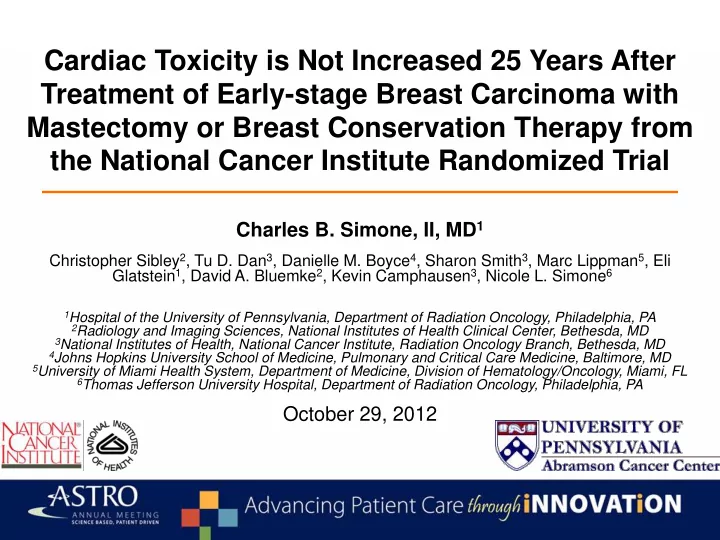

Cardiac Toxicity is Not Increased 25 Years After Treatment of Early-stage Breast Carcinoma with Mastectomy or Breast Conservation Therapy from the National Cancer Institute Randomized Trial Charles B. Simone, II, MD 1 Christopher Sibley 2 , Tu D. Dan 3 , Danielle M. Boyce 4 , Sharon Smith 3 , Marc Lippman 5 , Eli Glatstein 1 , David A. Bluemke 2 , Kevin Camphausen 3 , Nicole L. Simone 6 1 Hospital of the University of Pennsylvania, Department of Radiation Oncology, Philadelphia, PA 2 Radiology and Imaging Sciences, National Institutes of Health Clinical Center, Bethesda, MD 3 National Institutes of Health, National Cancer Institute, Radiation Oncology Branch, Bethesda, MD 4 Johns Hopkins University School of Medicine, Pulmonary and Critical Care Medicine, Baltimore, MD 5 University of Miami Health System, Department of Medicine, Division of Hematology/Oncology, Miami, FL 6 Thomas Jefferson University Hospital, Department of Radiation Oncology, Philadelphia, PA October 29, 2012
NCI Breast Conservation Trial Trial Registration Number: 79-C-0111 6 major randomized trials show BCT = MRM for outcomes for early stage breast cancer NCI Breast Conservation Trial • 237 patients with stage I-II breast cancer randomized from 1979-1986 – Arm 1: Modified radical mastectomy + axillary dissection (level I/II) – Arm 2: Lumpectomy + axillary dissection (level I/II) radiation • RT: 45-50.4 Gy whole breast +/- regional nodes, 15-20 Gy boost (Ir-192 or electrons) • CT simulation with dose inhomogeneity corrections – Node (+) patients (40%): AC (6-11 cycles) Might treatment toxicity be – TAM for postmenopausal N+ patients after 1985 causing separation of curves?
Cardiac Assessment • 50/102 (26 BCT, 24 MRM) remaining patients returned for follow- up – Detailed history and physical exam – Cardiac labs: • Lipid, CRP, homocysteine, HbA1c • ProBNP, creatinine, cystatin-c – Imaging: • Cardiac MRI - evaluate anatomy and function • CT angiogram – evaluate coronary artery disease and coronary arterial calcium (CAC) score
Results • Arms similar for pt characteristics, exam, and labs • Cardiac MRI – Left ventricular mass in BCT pts (91 gm vs. 110 gm, p=0.02) • Not significant after adjusting for systolic blood pressure – Peak midwall strain and chamber mass, volume and function all similar between arms • CT Angiogram – Median CAC was similar [BCT 25 (IQR 0, 86) vs. MRM 0 (IQR 0, 354), p=0.65] – Atherosclerosis - no significant difference • MRM vs. BCT • Left vs. right side no change in LAD or any other vessel – Visible atherosclerosis with chemo (HR 2.4, 95% CI 0.94-6.32, p=0.07)
Conclusions • 25 yrs after breast radiation, cardiac toxicity does not seem to be responsible for slight decrease in patient survival in the BCT arm • No difference noted for left-sided vs. right-sided tumors • Cardiac morbidity has been attenuated in patients treated with CT simulation and 3D planning Patients with early-stage breast cancer treated with radiotherapy do not have a higher risk of long-term cardiac morbidity compared with patients having mastectomy
Recommend
More recommend